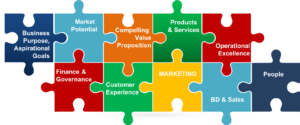
After 20 plus years working with organisations worldwide I’ve identified the 11 most common business process challenges. Day-to-day business processes serve as arteries carrying the life-blood of any business. Whether these business processes are efficient or inefficient, effective or ineffective, boring or exciting (rarely are they ever exciting!), they are the foundation required for all businesses to function.
The 11 most common business process challenges
#1 Business process not defined: because processes spring up out of a need to solve a business challenge, and then evolve toward a state of acceptance, most businesses do not have processes that are well designed and defined.
#2 Business process not owned: businesses are commonly managed vertically, where the organisation chart lays out a hierarchical structure of cascading leadership and management responsibilities and accountabilities. Yet work processes flow horizontally, across vertical boundaries usually because the customer end-to- end journey cuts horizontally through your business. If you want to create a seamless customer experience, you have to break down the traditional silo mentality of functions and departments working in isolation. The effective leadership and management of work must include the individual ownership of processes that cross boundaries and functions aligned to the overall customer experience.

#3 Purpose not understood: a process needs a worthy purpose to justify its existence. Without a worthy purpose, the entire process is non-value added and should be eliminated. Even for the simplest process with a single output, the process must provide something that a customer (internal or external) values and align to the overall goals and vision of the business.
#4 Business process not followed: perhaps the most obvious one but also the most common. Processes are designed to be followed. When they are, they can deliver a predictable, repeatable, sustainable result; when they are not, you lose control of the outcome. This is usually a personality problem, rather than a process one.
#5 Customer not understood: every process serves a customer and should create something of value, but process owners (assuming they exist) rarely know who their actual customers are, what they want from the process, and what they think of the value of the process in terms of how it meets their needs.

#6 Supplier not understood: a supplier also serves every process. Just like the customer, most process owners do not know the supplier of their process, what the process needs from their supplier, and to what extent the process needs are being served effectively by their supplier.
#7 Cumbersome to execute: because processes frequently grow into existence without intentional purpose or design, they tend to meander across businesses through the development of good ideas that add extra steps, poorly designed tasks, and additional workaround activities intended to accomplish what may have started out as a clean and simple process requirement.
#8 Loaded with non-value added work: value added tasks are defined as those tasks the customer would be willing to pay for. Limited value tasks are those that are of questionable value for the customer. All others are non-value added. For every process developed what are the value added, limited-value added, and non-value added tasks?
#9 Performance not measured: when businesses have front line measurements in place, they tend to be oriented vertically toward the organisation chart’s definition of responsibility and accountability. They also tend to be reactive (and too late to adjust) versus proactive. Good process measurement captures both process effectiveness (the extent to which the process satisfies the customer’s need or want) and process efficiency (the extent to which the process uses the minimum possible resources to do so).

#10 Not linked to strategy: we frequently hear senior leadership say things like: ‘We are committed to our strategy, but we can’t get the people to execute.’ Strategy without strong process is like a head without a body. Without having operational control of processes, it is nearly impossible to move the business toward a vision of the future.
#11 Don’t understand what business they are really in: There is nothing as galvanising for your people than a clear answer to your WHY. It also gives you enormous power of purpose when questioning, refining, and developing your processes to ensure they effectively lead you toward your WHY

Is it business process or personality?
A well-designed process may be an incredibly useful tool, but only if it is followed by people that understand it fully, and that’s a common challenge for many leaders. In my experience most people think they know their business processes and how they should work, but they very rarely have those processes documented.
A frequent and common response to this is usually ‘Our people know what they should be doing from a process point of view’. Really. When things go wrong it is usually down to one (or both) of the two Ps: process and/or personality.
If the process works on examination, the thing that led it to fail must be personality; specifically, a person. On the other hand, if the person has followed the process perfectly, then the personality isn’t in question and there is a fundamental problem with the process.
The two Ps is a simple but effective way to be able to diagnose quickly within your business where problems and opportunities exist.
To deliver and live up to the promises made to your customers and the marketplace, I want you to complete an audit of your systems, processes, and procedures and have a spring clean. Interrogate them. Ask why they exist; what purpose they serve, and whether there is a clear reason to be doing the things you are doing, in the way that you are doing them. Simplification must be one of your most aggressive operational goals.
The drivers or de-railers of your business growth

Check out the business growth blog series here…
10 business growth drivers or derailers
4 components of the customer experience you should know
5 steps to building a compelling value proposition
Sales forecasting & Planning: 4 things you should know
Why a cash management strategy is vital for business growth
Market Size: 13 questions to help you define the opportunity
How to write a strategic marketing plan
The importance of getting to know your people
One question you should ask to unlock your business transformation
Which kind of leader are you?


